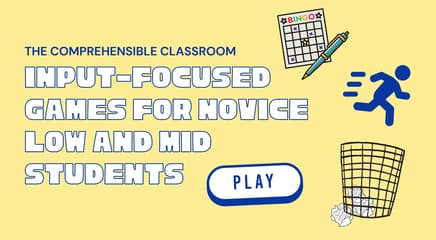As teachers are trying to decide if a text is a good fit for their learners, they will often ask us the question, "What ACTFL Level is this text?". Unfortunately, it's a question that we can't usually answer, and I want to explain why.
ACTFL Proficiency Guidelines do not describe texts; they describe people. Specifically, they describe a person's communicative ability. ACTFL Proficiency descriptors cannot be directly applied to the texts that teachers are using in their classes to help their students learn language.
Can Writing and Speaking descriptors be applied to texts?
ACTFL's Writing and Speaking Proficiency Guidelines describe the complexity and accuracy of a learner's speech or writing. Some teachers might think that if a learner is consistently performing at the Novice Mid level of proficiency, then they should be looking to read texts at or just above the Novice Mid level of proficiency. At first thought, this seems to make sense because of the Krashen's infamous "i+1" level of input, presented in his Comprehension Hypothesis. As teachers, we do aim to provide students with input that is meeting them where they are at and gently pushing them onward. If students are performing at Novice Low in their Presentational Writing ability, wouldn't it make sense to provide them with texts that are rated Novice Mid?
Well, this is what Novice Mid production looks like in Writing:
 ACTFL Proficiency Guidelines 2012, Page 14
ACTFL Proficiency Guidelines 2012, Page 14
"Novice Mid" texts, then, would be texts that have errors in spelling, symbols, and unintelligible at times... in addition to the other descriptors outlined in the sublevel paragraph! Looking at the Intermediate-range guidelines, we see that Intermediate-range writers can create connected sentences primarily in present time frame and have numerous, even significant errors. We would never intentionally give our students a text that contains errors, and so it is clear that we cannot use ACTFL's Writing or Speaking guidelines to describe texts that we want our learners to read.
Can Interpretive Reading descriptors be applied to texts?
If we can't use the Productive (Writing or Speaking) guidelines to describe interpretive ability, it makes sense to try out the Interpretive guidelines. Immediately, however, we have a problem: Proficiency is how a person communicates across contexts, consistently, in the "real world". Importantly, "real world" means outside the classroom context. When the Reading guidelines mention texts, they are not referring to texts that are created for language learners and found only in language classrooms. The texts that are being referenced in the Reading guidelines are texts that students would encounter in the real world; texts that are known as "authentic". To me, this immediately disqualifies us from using these descriptors to label texts that are created for language learners.
Furthermore, the preface to the Proficiency Guidelines for Reading states that the Reading Proficiency Guidelines "describe how readers understand written texts". The Guidelines are intended to describe the degree to which a learner can interpret texts.
Let's look at the Novice level of Reading Proficiency:
 ACTFL Proficiency Guidelines 2012, Page 21
ACTFL Proficiency Guidelines 2012, Page 21
Here, we see that a Novice learner is not described as being able to understand a complete text. They can only get limited information from a text; if they get more than limited information from a text, they are now performing in the Intermediate range or beyond.
The Comprehensible Classroom, and many other authors and companies, write texts with the intent that students can understand the full text, in its entirety, at a deep level. At no point do we expect learners to only be able to understand a few key words of texts that we create. ACTFL's Interpretive Guidelines, which are intended to describe how readers understand written texts, cannot be used to describe texts.
What information do I need to choose texts for my learners?
Although asking for the ACTFL Level of a text won't be useful in selecting things for your learners to read, the good news is that there is plenty of information out there that IS useful to you in finding 'good fit' texts for your learners.
In order to determine whether your students are ready to read a given text that is written for language learners, it is most helpful to ask the authors or publishers for information about text complexity. Even better, learning how to analyze the complexity of a text on your own will help you to make decisions confidently for your own classes.
What do I need to know about text complexity?
Text complexity encompasses things like vocabulary range, word frequency, sentence length and structure, text length, and text features such as images and headings.
Just like when children are learning to read in their first language, they need scaffolded exposure to factors that impact text complexity. They need to begin reading texts with a very limited vocabulary range and then read texts with gradually increasing vocabulary ranges. They need to begin reading texts with a few short sentences on each page and then read texts with slightly longer sentences, and a few more sentences on each page.
Here are some useful resources to help you and your administrators learn about text complexity so that you can better find the resources you need:





